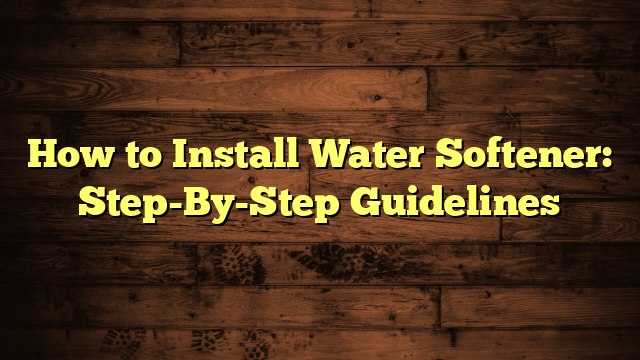How to Install Water Softener: Step-By-Step Guidelines
To install a water softener, start by turning off your main water supply. Evaluate your space and gather tools like wrenches and a pipe cutter. Cut the cold water line and attach a bypass valve to redirect water. Connect the inlet and outlet ports, ensuring the flow direction is correct, and secure everything with Teflon tape. Next, position the brine tank nearby, level it, and fill it with salt. Turn the water supply back on and check for leaks. For peak performance, test the system regularly and monitor salt levels. Stick around for more tips and tricks!
Key Takeaways
- Conduct a site assessment to find an optimal installation location near the main water supply and drainage.
- Gather necessary tools such as pipe cutters, wrenches, and Teflon tape before starting the installation.
- Turn off the main water supply to prevent leaks during the installation process.
- Create plumbing connections by cutting the cold water line and attaching a bypass valve for water diversion.
- Position the brine tank near the softener, fill it with salt, and connect an overflow tube to prevent spills.
Understanding Water Softening
Understanding water softening is essential for anyone looking to improve their home's water quality. Water hardness comes from minerals like calcium and magnesium that accumulate in your water supply. These minerals can lead to various issues, such as scale buildup in pipes, reduced efficiency of appliances, and dry skin or hair after bathing.
By installing a water softener, you can effectively remove these hard minerals through a process called ion exchange. This process replaces calcium and magnesium ions with sodium or potassium ions, resulting in softened water.
The benefits of using a water softener are numerous. You'll notice cleaner dishes, less soap scum on your shower walls, and softer laundry. Plus, it can extend the lifespan of your plumbing and appliances, saving you money in the long run.
Choosing the Right Water Softener
When choosing the right water softener, you need to take into account both the types available and the sizing that fits your home.
Different systems work better for various water conditions, so it's crucial to evaluate your needs.
Types of Water Softeners
Choosing the right water softener can greatly enhance your home's water quality and comfort. You'll typically encounter two main types: salt-based systems and electronic softeners.
Salt-based systems are the most common choice. They work by exchanging calcium and magnesium ions in your water with sodium ions, effectively softening it. These systems require regular maintenance, including salt refills, but they're highly effective at tackling hard water issues. If you have significant hard water problems, a salt-based system might be your best bet.
On the other hand, electronic softeners offer a more modern approach. They use electromagnetic waves to alter the properties of minerals in the water, preventing them from forming scale. While they don't remove hardness minerals like salt-based systems, they can reduce scale buildup and improve the overall efficiency of your plumbing.
Electronic softeners are often more compact and require less maintenance, making them a convenient option for some homeowners.
When deciding between these types, consider your specific needs, budget, and the level of hard water in your home. Each type has its advantages, so think about what'll work best for you.
Sizing Considerations for Softeners
Selecting the right size water softener is key to guaranteeing it operates efficiently and meets your household's needs. To do this, you'll first need to determine your water hardness. You can typically find this information on your water bill or by testing your water with a hardness kit.
Once you know the hardness level, you can calculate your capacity requirements.
Next, evaluate your household's daily water usage. Generally, the average person uses about 75 to 100 gallons of water per day. Multiply this by the number of people in your home to get your total daily water usage.
Then, use this figure alongside your water hardness to find the right water softener capacity.
Most softeners are rated by the number of grains they can remove before needing to regenerate. As a rule of thumb, choose a softener that can handle at least 30,000 to 40,000 grains for a family of four with moderate water hardness.
This way, you'll guarantee you have enough capacity to handle your needs while avoiding frequent regeneration.
Tools and Materials Needed
Before you start installing your water softener, you'll need to gather some essential tools and materials.
Creating a checklist will help guarantee you have everything on hand, including safety gear to protect yourself during the process.
Let's break down what you'll need to make the installation smooth and efficient.
Essential Tools Overview
To successfully install a water softener, you'll need a few essential tools and materials to make the process smoother.
Start with a pipe wrench and adjustable pliers; these will help you manipulate and secure various plumbing connections. A screwdriver set is also important, as you'll need both flathead and Phillips-head screwdrivers for assembly and adjustments.
Next, you should have a level on hand to guarantee your water softener is installed straight, which is crucial for proper operation. For cutting pipes, a pipe cutter is highly recommended, as it provides a clean and precise cut, reducing the risk of leaks.
Don't forget to have a bucket or towel ready to catch any water that might spill during the installation.
Lastly, consider safety gear like gloves and goggles, especially if you're working with tools that require significant force or if you're cutting into existing plumbing.
Required Materials Checklist
As you prepare to install your water softener, having the right materials on hand is crucial for a smooth process. Start by gathering a water quality test kit to assess your current water conditions. This will help you determine the specific type of softener you need for maximum softener efficiency.
Next, you'll require various plumbing materials. Make sure you have PVC pipes, fittings, and connectors tailored to your system's requirements. A drain hose is also necessary for the backwash process. You might need a bypass valve to redirect water flow when maintenance is needed.
Don't forget essential supplies like Teflon tape, which will help seal connections and prevent leaks. Furthermore, a brine tank and salt pellets are critical for the softening process. Depending on your water type, you may also want a pre-filter to enhance softener efficiency.
Finally, keep a bucket handy for salt and a wrench for tightening fittings. Having these materials ready will guarantee a seamless installation, leading to improved water quality and performance from your new water softener.
Safety Gear Importance
Installing a water softener involves more than just the right materials; safety gear plays a significant role in protecting you throughout the process. When tackling this project, you want to make sure you're well-equipped to handle any potential hazards.
Wearing safety goggles is vital as they shield your eyes from debris and splashes, especially when working with water or chemicals.
Don't forget to use heavy-duty gloves, too. They'll protect your hands from sharp edges, rough surfaces, and any harmful substances you might encounter.
Steel-toed boots are also a smart choice, as they'll safeguard your feet from falling objects during installation.
Additionally, consider wearing a dust mask if you're working in a confined space or with materials that create dust. This simple precaution can help you avoid respiratory issues.
Lastly, keep a first-aid kit on hand. While you hope not to need it, having one readily available guarantees you're prepared for any minor injuries.
Preparing the Installation Site
Before diving into the actual setup, it's crucial to prepare the installation site for your water softener. Start with a thorough site assessment. Identify a location that's close to your main water supply line, as this will make the installation more efficient.
Look for a space that has good drainage and is free from excessive moisture, as this can affect the unit's performance.
Next, consider plumbing considerations. Verify you have access to both cold and hot water lines, as well as a nearby electrical outlet if your system requires power.
It's also important to check the dimensions of your water softener to confirm that the chosen space can accommodate it comfortably. Keep in mind any potential obstacles, like pipes or electrical fixtures, that could hinder the installation process.
Lastly, clear the area of any clutter or debris. A clean workspace not only makes the installation easier but also minimizes the risk of accidents.
With the site properly assessed and prepared, you'll be ready to move forward confidently with your water softener installation.
Connecting the Water Softener
Once you've prepared your installation site, it's time to connect the water softener to your plumbing system. Start by turning off the main water supply to prevent any leaks during installation.
You'll need to create plumbing connections that facilitate water flow to and from the softener. Use a pipe cutter to remove a section of the incoming cold water line where you'll install the unit.
Next, attach the bypass valve to the water softener. This valve allows you to divert water around the softener whenever needed. Secure it with Teflon tape to guarantee a watertight seal.
Now, connect the softener's inlet and outlet ports to the plumbing using appropriate fittings, making sure they match the direction of water flow indicated on the unit.
Once your plumbing connections are made, check for any leaks by turning the water supply back on. Monitor the connections closely for a few minutes, tightening any loose fittings if necessary.
With everything securely in place, you can move on to the next steps of setting up the brine tank.
Setting Up the Brine Tank
Setting up the brine tank is essential for your water softener's operation, as it stores the salt needed for the regeneration process. A properly configured brine tank guarantees efficient salt dosage and peak performance. Here's how to get it right:
- Position the Brine Tank: Place the brine tank near your water softener, making certain it's level and stable. Ensure it's also easy to access for maintenance.
- Connect the Overflow Tube: Attach the overflow tube to prevent any potential spills. This tube should lead to a drain or outside to avoid any water damage in your home.
- Add Salt: Pour the appropriate amount of salt into the brine tank, following the manufacturer's recommendations for salt dosage. Typically, it's recommended to fill the tank about two-thirds full, but check the guidelines for your specific model.
Once you've completed these steps, you'll have your brine tank set up and ready to support your water softener.
Regularly check the salt level and refill as needed to maintain peak performance. With a well-maintained brine tank, your water softener will work efficiently for years to come!
Testing the System
Regularly testing the system guarantees your water softener operates efficiently and delivers the desired water quality.
To verify everything's working as it should, start by checking the hardness level of your water. You can use a simple test kit, which is an easy and effective testing method. Just follow the instructions, and within moments, you'll know if the water softener is doing its job.
Next, examine the brine tank. If the salt level is low, it could affect the water quality. Refill it if necessary, and make sure to use the right type of salt for peak performance.
Also, keep an eye on the system's regeneration cycle. This process is vital for maintaining softened water. If you notice longer intervals between regenerations, it might indicate a problem that needs attention.
Lastly, consider testing for specific contaminants in your water, like iron or chlorine. This guarantees your water softener is meeting all your needs.
Maintenance Tips for Longevity
To guarantee your water softener lasts for years, consistent maintenance is essential.
Regular upkeep not only enhances performance but also extends its lifespan. Here are three key tips to keep in mind:
1. Monitor Salt Levels: Check the salt levels in the brine tank monthly.
Keeping them between one-quarter and one-half full guarantees effective regeneration cycles. Low salt can lead to insufficient softening and damage the system.
2. Schedule Regeneration Cycles: Adjust the regeneration cycles based on your water usage.
Most systems have a preset schedule, but you might need to tweak it according to your household's needs. This prevents overworking the system and maintains its efficiency.
3. Clean the Resin Tank: At least once a year, Clean the Resin Tank to remove any buildup.
This helps maintain peak performance and prevents clogs that could hinder the softener's function.
Frequently Asked Questions
How Long Does the Installation Process Typically Take?
When it comes to installation duration, it really depends on the installation complexity. Generally, you can expect it to take a few hours, but if you're handy, you might finish even quicker.
Can I Install a Water Softener Myself?
Yes, you can install a water softener yourself! With the right DIY installation skills and installation tools, you'll manage the process successfully. Just follow instructions carefully, and you'll enjoy softened water in no time.
What Are the Signs I Need a Water Softener?
Noticing hard water indicators like scale buildup, dry skin, or dull laundry? You're likely in need of a water softener. The benefits of softening make life easier, enhancing your home's water quality considerably.
Are There Any Plumbing Codes to Consider?
Yes, you'll need to take into account plumbing permits and installation standards when installing a water softener. Check local regulations to guarantee compliance, as they can vary greatly and impact your installation process and overall efficiency.
How Much Does a Water Softener Cost?
You might think water softeners are pricey, but water softener prices vary widely. On average, you'll spend between $400 to $3,000, factoring in installation expenses, depending on the system's size and features.
Conclusion
Installing a water softener can transform your home, elevate your water quality, and enhance your daily life. By following these steps, you're not just making a practical choice; you're investing in comfort, convenience, and peace of mind. Enjoy the benefits of softer water, protect your appliances, and feel the difference every time you wash or shower. Embrace the change, appreciate the ease, and relish the results—your home deserves nothing less.







